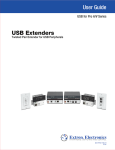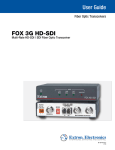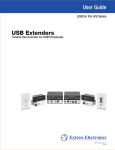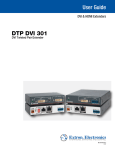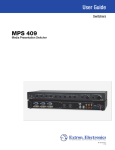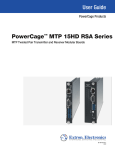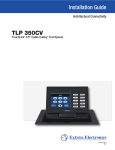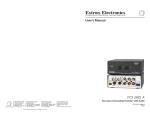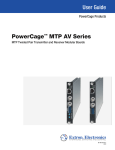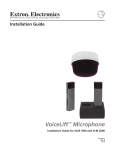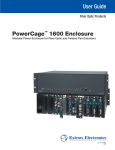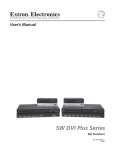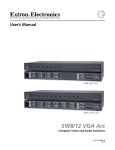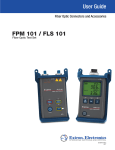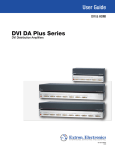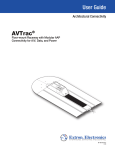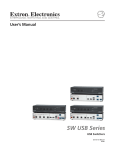Download USB Extender Series Installation Manual
Transcript
User Guide TP Series User Manual USB Extenders Twisted Pair Transmitter and Receiver 68-1719-01 Rev. A 04 10 Safety Instructions • English Warning This symbol is intended to alert the user of important operating and maintenance (servicing) instructions in the literature provided with the equipment. Power sources • This equipment should be operated only from the power source indicated on the product. This equipment is intended to be used with a main power system with a grounded (neutral) conductor. The third (grounding) pin is a safety feature, do not attempt to bypass or disable it. This symbol is intended to alert the user of the presence of uninsulated dangerous voltage within the product’s enclosure that may present a risk of electric shock. Power disconnection • To remove power from the equipment safely, remove all power cords from the rear of the equipment, or the desktop power module (if detachable), or from the power source receptacle (wall plug). Caution Read Instructions • Read and understand all safety and operating instructions before using the equipment. Retain Instructions • The safety instructions should be kept for future reference. Follow Warnings • Follow all warnings and instructions marked on the equipment or in the user information. Avoid Attachments • Do not use tools or attachments that are not recommended by the equipment manufacturer because they may be hazardous. Consignes de Sécurité • Français Ce symbole sert à avertir l’utilisateur que la documentation fournie avec le matériel contient des instructions importantes concernant l’exploitation et la maintenance (réparation). Ce symbole sert à avertir l’utilisateur de la présence dans le boîtier de l’appareil de tensions dangereuses non isolées posant des risques d’électrocution. Attention Lire les instructions• Prendre connaissance de toutes les consignes de sécurité et d’exploitation avant d’utiliser le matériel. Conserver les instructions• Ranger les consignes de sécurité afin de pouvoir les consulter à l’avenir. Respecter les avertissements • Observer tous les avertissements et consignes marqués sur le matériel ou présentés dans la documentation utilisateur. Power cord protection • Power cords should be routed so that they are not likely to be stepped on or pinched by items placed upon or against them. Servicing • Refer all servicing to qualified service personnel. There are no user-serviceable parts inside. To prevent the risk of shock, do not attempt to service this equipment yourself because opening or removing covers may expose you to dangerous voltage or other hazards. Slots and openings • If the equipment has slots or holes in the enclosure, these are provided to prevent overheating of sensitive components inside. These openings must never be blocked by other objects. Lithium battery • There is a danger of explosion if battery is incorrectly replaced. Replace it only with the same or equivalent type recommended by the manufacturer. Dispose of used batteries according to the manufacturer’s instructions. Eviter les pièces de fixation • Ne pas utiliser de pièces de fixation ni d’outils non recommandés par le fabricant du matériel car cela risquerait de poser certains dangers. Avertissement Alimentations • Ne faire fonctionner ce matériel qu’avec la source d’alimentation indiquée sur l’appareil. Ce matériel doit être utilisé avec une alimentation principale comportant un fil de terre (neutre). Le troisième contact (de mise à la terre) constitue un dispositif de sécurité : n’essayez pas de la contourner ni de la désactiver. Déconnexion de l’alimentation• Pour mettre le matériel hors tension sans danger, déconnectez tous les cordons d’alimentation de l’arrière de l’appareil ou du module d’alimentation de bureau (s’il est amovible) ou encore de la prise secteur. Protection du cordon d’alimentation • Acheminer les cordons d’alimentation de manière à ce que personne ne risque de marcher dessus et à ce qu’ils ne soient pas écrasés ou pincés par des objets. Réparation-maintenance • Faire exécuter toutes les interventions de réparation-maintenance par un technicien qualifié. Aucun des éléments internes ne peut être réparé par l’utilisateur. Afin d’éviter tout danger d’électrocution, l’utilisateur ne doit pas essayer de procéder lui-même à ces opérations car l’ouverture ou le retrait des couvercles risquent de l’exposer à de hautes tensions et autres dangers. Fentes et orifices • Si le boîtier de l’appareil comporte des fentes ou des orifices, ceux-ci servent à empêcher les composants internes sensibles de surchauffer. Ces ouvertures ne doivent jamais être bloquées par des objets. Sicherheitsanleitungen • Deutsch Lithium Batterie • Il a danger d’explosion s’ll y a remplacment incorrect de la batterie. Remplacer uniquement avec une batterie du meme type ou d’un ype equivalent recommande par le constructeur. Mettre au reut les batteries usagees conformement aux instructions du fabricant. Vorsicht Dieses Symbol soll dem Benutzer in der im Lieferumfang enthaltenen Dokumentation besonders wichtige Hinweise zur Bedienung und Wartung (Instandhaltung) geben. Stromquellen • Dieses Gerät sollte nur über die auf dem Produkt angegebene Stromquelle betrieben werden. Dieses Gerät wurde für eine Verwendung mit einer Hauptstromleitung mit einem geerdeten (neutralen) Leiter konzipiert. Der dritte Kontakt ist für einen Erdanschluß, und stellt eine Sicherheitsfunktion dar. Diese sollte nicht umgangen oder außer Betrieb gesetzt werden. Dieses Symbol soll den Benutzer darauf aufmerksam machen, daß im Inneren des Gehäuses dieses Produktes gefährliche Spannungen, die nicht isoliert sind und die einen elektrischen Schock verursachen können, herrschen. Stromunterbrechung • Um das Gerät auf sichere Weise vom Netz zu trennen, sollten Sie alle Netzkabel aus der Rückseite des Gerätes, aus der externen Stomversorgung (falls dies möglich ist) oder aus der Wandsteckdose ziehen. Achtung Lesen der Anleitungen • Bevor Sie das Gerät zum ersten Mal verwenden, sollten Sie alle Sicherheits-und Bedienungsanleitungen genau durchlesen und verstehen. Aufbewahren der Anleitungen • Die Hinweise zur elektrischen Sicherheit des Produktes sollten Sie aufbewahren, damit Sie im Bedarfsfall darauf zurückgreifen können. Befolgen der Warnhinweise • Befolgen Sie alle Warnhinweise und Anleitungen auf dem Gerät oder in der Benutzerdokumentation. Keine Zusatzgeräte • Verwenden Sie keine Werkzeuge oder Zusatzgeräte, die nicht ausdrücklich vom Hersteller empfohlen wurden, da diese eine Gefahrenquelle darstellen können. Instrucciones de seguridad • Español Este símbolo se utiliza para advertir al usuario sobre instrucciones importantes de operación y mantenimiento (o cambio de partes) que se desean destacar en el contenido de la documentación suministrada con los equipos. Este símbolo se utiliza para advertir al usuario sobre la presencia de elementos con voltaje peligroso sin protección aislante, que puedan encontrarse dentro de la caja o alojamiento del producto, y que puedan representar riesgo de electrocución. Precaucion Leer las instrucciones • Leer y analizar todas las instrucciones de operación y seguridad, antes de usar el equipo. Conservar las instrucciones • Conservar las instrucciones de seguridad para futura consulta. Obedecer las advertencias • Todas las advertencias e instrucciones marcadas en el equipo o en la documentación del usuario, deben ser obedecidas. 安全须知 • 中文 这个符号提示用户该设备用户手册中有重要的操作和维护说明。 这个符号警告用户该设备机壳内有暴露的危险电压,有触电危险。 注意 阅读说明书 • 用户使用该设备前必须阅读并理解所有安全和使用说明。 保存说明书 • 用户应保存安全说明书以备将来使用。 遵守警告 • 用户应遵守产品和用户指南上的所有安全和操作说明。 避免追加 • 不要使用该产品厂商没有推荐的工具或追加设备,以避免危险。 Schutz des Netzkabels • Netzkabel sollten stets so verlegt werden, daß sie nicht im Weg liegen und niemand darauf treten kann oder Objekte darauf- oder unmittelbar dagegengestellt werden können. Wartung • Alle Wartungsmaßnahmen sollten nur von qualifiziertem Servicepersonal durchgeführt werden. Die internen Komponenten des Gerätes sind wartungsfrei. Zur Vermeidung eines elektrischen Schocks versuchen Sie in keinem Fall, dieses Gerät selbst öffnen, da beim Entfernen der Abdeckungen die Gefahr eines elektrischen Schlags und/oder andere Gefahren bestehen. Schlitze und Öffnungen • Wenn das Gerät Schlitze oder Löcher im Gehäuse aufweist, dienen diese zur Vermeidung einer Überhitzung der empfindlichen Teile im Inneren. Diese Öffnungen dürfen niemals von anderen Objekten blockiert werden. Litium-Batterie • Explosionsgefahr, falls die Batterie nicht richtig ersetzt wird. Ersetzen Sie verbrauchte Batterien nur durch den gleichen oder einen vergleichbaren Batterietyp, der auch vom Hersteller empfohlen wird. Entsorgen Sie verbrauchte Batterien bitte gemäß den Herstelleranweisungen. Evitar el uso de accesorios • No usar herramientas o accesorios que no sean especificamente recomendados por el fabricante, ya que podrian implicar riesgos. Advertencia Alimentación eléctrica • Este equipo debe conectarse únicamente a la fuente/tipo de alimentación eléctrica indicada en el mismo. La alimentación eléctrica de este equipo debe provenir de un sistema de distribución general con conductor neutro a tierra. La tercera pata (puesta a tierra) es una medida de seguridad, no puentearia ni eliminaria. Desconexión de alimentación eléctrica • Para desconectar con seguridad la acometida de alimentación eléctrica al equipo, desenchufar todos los cables de alimentación en el panel trasero del equipo, o desenchufar el módulo de alimentación (si fuera independiente), o desenchufar el cable del receptáculo de la pared. Protección del cables de alimentación • Los cables de alimentación eléctrica se deben instalar en lugares donde no sean pisados ni apretados por objetos que se puedan apoyar sobre ellos. Reparaciones/mantenimiento • Solicitar siempre los servicios técnicos de personal calificado. En el interior no hay partes a las que el usuario deba acceder. Para evitar riesgo de electrocución, no intentar personalmente la reparación/mantenimiento de este equipo, ya que al abrir o extraer las tapas puede quedar expuesto a voltajes peligrosos u otros riesgos. Ranuras y aberturas • Si el equipo posee ranuras o orificios en su caja/alojamiento, es para evitar el sobrecalientamiento de componentes internos sensibles. Estas aberturas nunca se deben obstruir con otros objetos. Batería de litio • Existe riesgo de explosión si esta batería se coloca en la posición incorrecta. Cambiar esta batería únicamente con el mismo tipo (o su equivalente) recomendado por el fabricante. Desachar las baterías usadas siguiendo las instrucciones del fabricante. 警告 电源 • 该设备只能使用产品上标明的电源。 设备必须使用有地线的供电系统供电。 第三条线 (地线)是安全设施,不能不用或跳过 。 拔掉电源 • 为安全地从设备拔掉电源,请拔掉所有设备后或桌面电源的电源线,或任何接到市 电系统的电源线。 电源线保护 • 妥善布线, 避免被踩踏,或重物挤压。 维护 • 所有维修必须由认证的维修人员进行。 设备内部没有用户可以更换的零件。为避免出 现触电危险不要自己试图打开设备盖子维修该设备。 通风孔 • 有些设备机壳上有通风槽或孔,它们是用来防止机内敏感元件过热。 不要用任何东 西挡住通风孔。 锂电池 • 不正确的更换电池会有爆炸的危险。必须使用与厂家推荐的相同或相近型号的电池。 按照生产厂的建议处理废弃电池。 FCC Class A Notice This equipment has been tested and found to comply with the limits for a Class A digital device, pursuant to part 15 of the FCC Rules. Operation is subject to the following two conditions: 1. This device may not cause harmful interference. 2. This device must accept any interference received, including interference that may cause undesired operation. The Class A limits are designed to provide reasonable protection against harmful interference when the equipment is operated in a commercial environment. This equipment generates, uses, and can radiate radio frequency energy and, if not installed and used in accordance with the instruction manual, may cause harmful interference to radio communications. Operation of this equipment in a residential area is likely to cause harmful interference, in which case the user will be required to correct the interference at his own expense. NOTE: This unit was tested with shielded cables on the peripheral devices. Shielded cables must be used with the unit to ensure compliance with FCC emissions limits. Copyright © 2010 Extron Electronics. All rights reserved. Trademarks All trademarks mentioned in this manual are the properties of their respective owners. Contents Introduction ............................................ 1 Reference Information........................... 13 About this Manual........................................... 1 About the USB Extender Tx/Rx.......................... 2 TP cable advantages........................................ 3 Features............................................................ 3 Specifications.................................................. 14 Part Numbers.................................................. 15 Included Parts............................................. 15 Accessories..................................................... 16 TP Cable Termination...................................... 17 Mounting the USB Extender............................ 19 Tabletop placement..................................... 19 Rack Mounting........................................... 19 Under-furniture mounting.......................... 21 Through-furniture mounting...................... 22 Projector mounting..................................... 23 Installation and Operation . ................... 5 Installation Overview......................................... 5 Mounting Options............................................ 6 Tabletop Placement....................................... 6 Rack Mounting............................................. 6 Under-furniture mounting............................ 6 Through-furniture mounting........................ 6 Projector mounting....................................... 6 Connections..................................................... 7 Transmitter.................................................... 7 Receiver........................................................ 8 Operation......................................................... 9 Transmitter Indicators.................................... 9 Receiver Indicators........................................ 9 Cabling and Set up..................................... 10 System Operation........................................... 11 Troubleshooting.............................................. 12 USB Extenders • Contents v USB Extenders • Contents vi Introduction This section provides details about the manual and the product. • About this Manual • About the USB Extender Tx/Rx • TP Cable Advantages • Features About this Manual This manual contains information to install, configure and operate Extron Electronics USB Extender Tx/Rx transmitter and receiver. NOTE: In this manual, unless otherwise specified, the term “Tx/Rx” or “extender” refers to either product. Notes, Tips, Cautions, and Warnings NOTE: Notes call attention to information that may be of special importance. TIP:Tech Tips provide technical information that may be helpful during installation, for performing a procedure or adjustment, or in the operation of the USB Extenders. CAUTION: Indicates a potential hazard to equipment or data may exist. WARNING: Indicates a potential hazard to personal safety exists. USB Extenders • Introduction 1 About the USB Extender Tx/Rx The USB Extender Tx/Rx is a family of USB transmitters and receivers in enclosures supporting a variety of mounting options. A transmitter and receiver extend the distance of USB data over a single Category (CAT) 5 (or better) unshielded twisted pair (UTP) or shielded twisted pair (STP) cable. The USB signals can be transmitted up to 450 feet (137 m) using category cable. Extron USB Extender RX Twisted Pair Receiver for USB Peripherals B HU 3 1 T NO T DONNEC N CO LA TO ST HO CAT 5/5e/6/7 up to 450' (135m) K LIN ER W POV AX T 2 NO T DONNEC N CO LA TO R WE POV AX 12 M 1.0A K LIN 4 USB 12 M 0.4A USB Extron USB Extender TX Twisted Pair Transmitter for USB Peripherals USB Touchscreen Display 2 -23 RS 2 -23 RS E US SE T RE N LA MO B US RD OA YB KE B/ B-Y I DV T OU P MT G/ Y R/ R-Y Y, R- B/ Y, Y B- RG I/ SD HD I SD VID /Y VID /Y Y G/ VID 3 C B/ Y B- 7 O U T P U T S S V H I-D 5 DV 6 4 C R/ Y R- B-Y /C Y RV 1 Extron Annotator -Y Y,B I -Y, N RGB/R P U 2 -Y Y,B T -Y, S RGB/R .5A V 0Hz -240 50/6 HV H/ X MA 100 Annotation Graphics Processor Projector/Display Figure 1. Typical transmitter and receiver application A USB Extender system consists of a transmitter (Tx) and a receiver (Rx). The transmitter connects directly to a USB port on a PC or USB host. The receiver features a four port USB hub to connect multiple peripheral devices. The USB Extender series complies with the USB 2.0 standard, supporting USB 2.0, (480 Mbps high speed), USB 1.1, (12 Mbps full speed) and USB 1.0, (1.5 Mbps low speed) for data transmission throughout the system. It also supplies +5 VDC (up to 500 mA) on each of the receiver USB peripheral ports. Both transmitter and receiver feature a front panel USB host activity LED and a twisted pair Link LED for local or remote troubleshooting. The USB Extenders are in a three inch deep, quarter rack width, 1 inch high metal enclosure. They can be set on a tabletop, or mounted in a rack, under or through furniture, or to a projector pole. USB Extenders • Introduction 2 TP Cable Advantages Twisted pair cable is much smaller, lighter, more flexible, and less expensive than USB cable. These transmitter and receiver twisted pair (TP) products make cable runs simpler and less cumbersome. Termination of the cable with RJ-45 connectors is simple, quick, and economical. NOTE:The transmitter and receiver pair work with unshielded twisted pair (UTP) or shielded twisted pair (STP) cables; but to ensure FCC Class A and CE compliance, STP cables are required. Features • Transmits USB signals over CAT 5/5e/6/7 cables — Standard twisted pair cables provide an economical, easily installed cable solution. • Long distance transmission — оо CAT 5/5e/6/7 UTP/STP cable — up to 450 feet (137 m) • One inch high, quarter rack width, metal enclosures — With low profile enclosures, transmitters and receivers can be discreetly installed in locations such as behind a plasma or LCD flat-panel display. • External 100 VAC to 240 VAC, 50-60 Hz, international power supply — Included with each transmitter and each receiver USB Extenders • Introduction 3 Video UT L/ TP RO OU NT CO WER PO Extron MLS 102 VGA MediaLink® Switcher T OU 2 IX X/M AU NO MO TS PU IN 4 L S UT R INP 3 DIO L 1 R RS-232 Control Out R L A B .5A MAX V 12 AU 2 1 R CLEA NCY ERGE EM ERT AL A 2 VG MLS 10 -232 RS Tx B UT TP HU B3 US B OU US Rx T AC NT CO 3 4 2 1 Tx B2 US Extron CCR-2BLB AAP Contact Closure -232 RS THRU SS PA B4 US B1 Controller Module US T G IN Extron SW2 USB Two Input USB Switcher PC USB 2 1 R WE PO X V 12 A MA 1.5 + Video PC PU IN ITCH B SW US Video HO ST T NO TT DONNEC NO N T LA EC CO DO NN N TO CO LA TO K LIN K LIN T Txx 011 Tx B 20 1 US B 20 US WER POV X. Extron USB Extender Tx 12A MA 2.0 USB CAT5 Cable USB Transmitter Laptop PC B HU 1 Rx B 20 3 4 1 US USB T 2 NO T DONNEC N CO LA TO WER POV X. Extron USB Extender Rx 12A MA 2.0 K LIN P 102 AA USB Receiver Interactive Display Figure 2. USB Extender Application Diagram USB Extenders • Introduction 4 Installation and Operation This section provides the following details: • Installation Overview • Mounting Options • Connections • Operation • Troubleshooting Installation Overview Install and set up the USB Extender series as follows: 1. Shut off power to all devices that will be directly connected to the USB Extender transmitter or receiver. 2. Choose a location and mount the transmitter and receiver. оо If rack mounting, fasten the cabinet to the rack. оо If furniture mounting, install the mounting brackets (not included), then fasten the brackets to the furniture. Consult the mounting instructions for the mounting option for further details. 3. Run a Twisted Pair cable between the transmitter and receiver and connect to the rear panel LINK ports. 4. Connect an external power supply to the receiver. If the PC or laptop cannot supply USB power, connect a supply to the transmitter. 5. Apply power to the USB extenders. Using the external supplies on both the transmitter and receiver, both power LEDs light. The Link LED also lights to indicate proper link cable connection between the transmitter and receiver. 6. Connect the PC (or other USB host device) to the USB Extender transmitter using an appropriate USB 2.0 compatible type A-B cable 7. Boot the PC. After the PC boots, the transmitter Host LED lights indicating communication between the PC and transmitter hub controller. Shortly after, the receiver Host LED lights indicating communication between the transmitter and receiver. If the PC is supplying transmitter power, the transmitter and receiver link LEDs light. 8. Connect USB peripherals to the USB Extender receiver using USB 2.0 compatible cables. 9. Turn on the various USB peripherals. As each peripheral is recognized by the PC, the appropriate hub LED on the receiver front panel lights. USB Extenders • Installation and Operation 5 Mounting Options Mounting instructions are included in Mounting the USB Extender on page 19 in the reference section. Mounting instructions are also included with each optional mounting kit. CAUTION: Installation and service must be performed by authorized personnel only. The three inch deep, one inch high, quarter rack width USB Extender transmitters and receivers can be placed on a tabletop, mounted on a rack shelf, or mounted under a desk or tabletop. The receiver can be mounted on a projector bracket. Tabletop Placement Affix the four included rubber feet to the bottom of the unit and place it in any convenient location. Rack Mounting For UL guidelines and optional rack mounting equipment, see Rack Mounting on page 19. Under-furniture mounting The unit can be mounted under a horizontal surface using an optional MBU 123, under‑desk mount Kit for 1/8 and 1/4 Rack Width products, (part #70-212-01). Through-furniture mounting The transmitter or receiver can be mounted through a desk or other furniture using an optional MBD 129, through‑desk mounting kit for quarter or half rack width products, part #70-077-02. Projector mounting The receiver can be mounted on a projector bracket using either of the following optional projector mounting kits: • PMK 300 multi-product pole mount kit (part #70-374-01) • PMK 350 low profile, multi-product pole mount kit (part #70-563-03) USB Extenders • Installation and Operation 6 Connections Transmitter The Tx transmitter rear panel (see figure 3) has a DC power input, one USB host type B female connector and a twisted pair link connection. POWER HOST 12V 0.4A MAX. DO NOT CONNECT TO LAN LINK a b c Figure 3. USB Extender Tx rear panel connectors a Power Input Connector — One two-pole, 3.5 mm captive screw connector is used to apply power to the transmitter from an external supply. If the USB port of a connected PC or laptop is capable of providing USB power, an external supply for the transmitter is not required. CAUTION: Always use a power supply provided or specified by Extron for the USB Extender transmitters and receivers. Use of an unauthorized power supply voids all regulatory compliance certification and may cause damage to the supply and the USB Extender. Unless otherwise stated, the AC/DC adapters are not suitable for use in air handling spaces or in wall cavities. The installation must always be in accordance with applicable provisions of National Electrical Code ANSI/NFPA 70, article 75 and the Canadian Electrical Code part 1, section 16. The power supply shall not be permanently fixed to building structure or similar structure. b USB Host connector — Connect a type A-B female USB cable between this port and the USB output port of a PC or laptop. The USB Extender is USB 2.0 compliant and able to support data transfers of 480 Mbps (high speed), 12 Mbps (full speed) and 1.5 Mbps (low speed). c Link (twisted pair) connector — Connect the TP cable from the receiver link connector (figure 4, item e) to this RJ-45 female connector. CAUTION: Do not connect this port to a computer data or telecommunications network. See TP Cable Termination on page 17, to properly wire the RJ-45 connectors. USB Extenders • Installation and Operation 7 Receiver The Rx receiver rear panel, (see figure 4), has a DC power input and twisted pair link connection and also has four USB hub type A female connectors. HUB POWER 12V 1.0A MAX. LINK d e 1 3 DO NOT CONNECT 2 TO LAN 4 f Figure 4. USB Extender Rx rear panel connectors d Power Input Connector — The receiver requires an external supply. Plug the included 12 VDC power supply into this 2-pole, 3.5 mm captive screw connector. e Link (twisted pair) connector — Connect the TP cable from the transmitter link connector (figure 3, item c) to this RJ-45 female connector. CAUTION: Do not connect this port to a computer data or telecommunications network. f USB hub connectors — The built-in four port hub uses four USB Type A female connectors. The connections are USB 2.0 compatible providing +5 VDC at up to 500 mA to connected USB peripherals requiring power. USB Extenders • Installation and Operation 8 Operation Transmitter Indicators Transmitters have three LED indicators on the front panel. ACTIVITY LINK HOST USB Extender Tx g h i Figure 5. Front panel indicators g Power LED — This front panel LED lights to indicate the unit is receiving power. h Link LED — Lights when the transmitter and receiver are successfully connected together by the twisted pair cabling and both transmitter and receiver are powered. i Host Activity LED — Blinks when the transmitter is powered and begins communication with the host PC. Receiver Indicators All receivers have a power, link and host indicator LED on the front panel similar to the transmitters, and also have four additional LEDs associated with the four USB hub ports. ACTIVITY LINK HOST 1 3 2 4 USB Extender Rx j k l m Figure 6. Front panel indicators, USB Extender Rx j Power LED — This front panel LED lights to indicate the unit is receiving power k Link LED — Lights when the transmitter and receiver are successfully connected together by the twisted pair cabling and both transmitter and receiver are powered. l Host Activity LED — Blinks when both the transmitter and receiver are powered, both are connected by the twisted pair cable, and the receiver begins communication with the host PC. m Hub Activity LEDs — A single LED lights when the peripheral on the associated USB port has been recognized by the host PC. USB Extenders • Installation and Operation 9 Cabling and Set up To ensure proper operation, the transmitter, receiver, USB host, and USB peripherals must be connected properly and in the sequence described below. Connections are the same regardless of which version is being installed. NOTE: If the USB Host is capable of powering the transmitter (0.4 A max), the external supply for the transmitter is not required. UTP or STP CAT5 or better cable. Terminate both ends identically, in accordance with either the TIA/EIA T 568A or the TIA/EIA T 568B wiring standard. PC Keyboard USB Transmitter POWER USB Receiver HOST HUB POWER 12V 0.4A MAX. 12V 1.0A MAX. DO NOT CONNECT TO LAN LINK LINK 1 3 DO NOT CONNECT 2 TO LAN 4 The receiver must have a power supply connected. Four USB 2.0 compatible type A female connectors provide +5 VDC at up to 500 mA to connected USB peripherals. If the USB host is capable of supplying power, the transmitter supply is not required. Ground +12 VDC Ground +12 VDC External Power Supply (12 VDC, 1 A ) External Power Supply (12 VDC, 1 A ) Figure 7. USB Extender connection guide with two external supplies Power down the USB host PC or laptop that will be connected to the transmitter and all peripherals and devices that will be connected to the receiver. If an external supply powers the transmitter: 1. Connect twisted pair cable between the USB Extender transmitter and receiver. 2. Connect one included power supply to the USB Extender receiver and one to the transmitter, then apply power. The power LEDs on the receiver and transmitter light. Additionally, with both units powered, the link LEDs light to indicate connectivity on the twisted pair link. 3. Connect a type A-B USB cable from the USB host to the USB Extender transmitter. 4. Apply power to the USB host. After the host has booted, the transmitter host LED blinks to indicate communications between the host and transmitter. Shortly after, the host LED on the receiver blinks to indicate the host is communicating with the hub controller (USB Extender receiver). 5. Connect USB peripherals (keyboard, mouse, scanner, printer, or other USB devices) to the receiver. As each peripheral is recognized by the host, the respective USB hub port LED lights. USB Extenders • Installation and Operation 10 If a host PC or laptop powers the transmitter: UTP or STP CAT5 or better cable. Terminate both ends identically, in accordance with either the TIA/EIA T 568A or the TIA/EIA T 568B wiring standard. PC Keyboard USB Transmitter POWER 12V 0.4A MAX. USB Receiver HOST HUB POWER 12V 1.0A MAX. DO NOT CONNECT TO LAN LINK USB host providing power. LINK 1 3 DO NOT CONNECT 2 TO LAN 4 Four USB 2.0 compatible type A female connectors provide +5 VDC at up to 500 mA to connected USB peripherals. Ground +12 VDC External Power Supply (12 VDC, 1 A ) Figure 8. USB Extender connection guide with host supply 1. Connect twisted pair cable between the USB Extender transmitter and receiver.. 2. Connect the included power supply to the USB Extender receiver and apply power. The power LED on the receiver lights. NOTE:The transmitter power LED and both link LEDs remain dark. 3. Connect a type A-B USB cable from the USB host to the USB Extender transmitter. 4. Apply power to the USB host and boot it up. The power LED on the transmitter and the link LEDs on both transmitter and receiver light. Once the host has booted, the transmitter host LED blinks to indicate communications between the host and transmitter. Shortly after, the host LED on the receiver blinks to indicate the host is communicating with the hub controller (USB Extender receiver). 5. Connect USB peripherals (keyboard, mouse, scanner, etc.) to the receiver. As each peripheral is recognized by the host, the respective USB hub port LED lights. System Operation No drivers are required for a host to function with the USB Extenders. The USB Extender will be detected by Windows and appropriate USB drivers loaded. Certain USB peripherals, such as gaming keyboards, USB interactive whiteboards, scanners, printers, and similar devices, require a PC to have the appropriate drivers installed. Refer to the USB device’s installation instructions or the peripheral manufacturer’s website for drivers. USB Extenders • Installation and Operation 11 Once the transmitter, the receiver, the PC or USB host, and peripherals are connected, have appropropriate drivers loaded, and are powered up, the system is fully operational. If problems are encountered, ensure all cables are routed and connected properly and the latest drivers for each peripheral are installed. Troubleshooting USB signals are generally very reliable but are susceptible to bad connections or cables that are too long. The TP cable is susceptible to the same issues. To avoid the loss of data and communications, follow these guidelines: • The USB cable on the transmitter host connection or the receiver hub ports should not exceed 10 feet (3 m). • When connecting the host or peripherals, use only cable designed for USB signals. • Avoid or limit the use of adapters. • The USB Extender works as described in point-to-point applications. Do not use additional adapters, patch panels, or couplers with the host USB cables, hub USB cables, or twisted pair cables. Additional links in the signal chain can result in the reduction of signal integrity and overall cable length performance. When properly connected and operating, both transmitter and receiver power LEDs, link LEDs and host LEDs will be lit. The hub LED for each connected peripheral recognized by the host PC is also lit. Front panel LEDs may also be useful for troubleshooting. The following table shows operating details indicated by the LEDs. Transmitter Receiver LED indicator On Off On Off Power 12 VDC supply is connected and operating properly 12 VDC supply is not connected or is defective. If a transmitter supply is not being used, USB host is either not on or is not providing power, or the USB cable is disconnected. 12 VDC supply is connected and operating properly 12 VDC supply is not connected or defective Link Both transmitter and receiver have power and TP cable is connected properly. TP cable is not connected to receiver or is improperly wired. If transmitter supply is not being used, USB host is either not on, or is not providing power. Both transmitter and receiver have power and TP cable is connected properly. TP cable is not connected to transmitter or is improperly wired. If transmitter supply is not being used, USB host is either not on, or is not providing power. Host When transmitter power LED is on, blinks when communications with host PC are established If transmitter power LED is on, USB cable is not connected or host is not communicating Blinks when communications with host PC are established Host USB is not connected or host is not communicating Hub N/A N/A Lights when the peripheral on the respective USB port has been recognized by the host PC Peripheral on the respective USB port has not been been recognized or is improperly connected Table 1: System Troubleshooting USB Extenders • Installation and Operation 12 Reference Information This section provides information on the following subjects: • Specifications • Part Numbers • Accessories • TP Cable Termination • Mounting the USB Extender USB Extenders • Reference Information 13 Specifications USB USB standards��������������������������������� USB 2.0, USB 1.1, USB 1.0 compatible USB data rates��������������������������������� Low speed (1.5 Mbps), full speed (12 Mbps), high speed (480 Mbps) Signal transmission distance������������� With CAT 5 cable: 450' (135 m) USB host — TX units Number/signal type�������������������������� 1 USB (supports USB 2.0, 1.1, 1.0 speeds) Connectors�������������������������������������� 1 female USB type B Interconnection between transmitter and receiver Connectors�������������������������������������� 1 female RJ-45 per unit Termination standards����������������������TIA 568A or TIA 568B Signal transmission distance������������� With CAT 5/5e/6/7 cable: 450' (135 m) NOTE: The transmission distance varies depending on the type of cable used in the system. USB hub— RX units Number/signal type�������������������������� (1) 4-port USB hub Connectors�������������������������������������� 4 female USB type A General Power���������������������������������������������� 100 VAC to 240 VAC, 50-60 Hz, external; to 12 VDC, 1 A, regulated Power input������������������������������������� 12 VDC, 0.4 A Temperature/humidity���������������������� Storage: -40 to +158 °F (-40 to +70 °C) / 10% to 90%, noncondensing Operating: +32 to +122 °F (0 to +50 °C) / 10% to 90%, noncondensing Cooling�������������������������������������������Convection, no vents Mounting Rack mount����������������������� Yes, with optional rack shelf or rack mounting brackets Furniture or wall mount����� Yes, with optional mounting kits Enclosure type��������������������������������� Metal Enclosure dimensions����������������������� 1.0" H x 4.3" W x 3.0" D (2.5 cm H x 10.9 cm W x 7.6 cm D) (Depth excludes connectors.) Product weight�������������������������������� 0.25 lbs (0.1 kg) Shipping weight������������������������������ 1 lb (<1 kg) Vibration����������������������������������������� ISTA 1A in carton (International Safe Transit Association) Regulatory compliance Safety��������������������������������CE, c-UL, UL EMI/EMC���������������������������CE, C-tick, FCC Class A, ICES, VCCI Class A Environmental�������������������Complies with the appropriate requirements of RoHS, WEEE MTBF����������������������������������������������� 30,000 hours Warranty����������������������������������������� 3 years parts and labor NOTE: All nominal levels are at ±10%. NOTE: Specifications are subject to change without notice. USB Extenders • Reference Information 14 Part Numbers Included Parts These items are included in each order for a USB Extender Tx or Rx: Description USB Extender Tx transmitter -orUSB Extender Rx receiver Part # 60-871-12 60-871-22 USB Extender Set up Guide 12 VDC, 1 A external power supply 70-755-01 Rubber Feet (4) NOTE: A power supply is included with each transmitter and each receiver. USB Extenders • Reference Information 15 Accessories Accessories Part number RSF 123, Rack Shelf Kit for 3.5 inch deep products 60-190-20 RSB 123, Basic Rack Shelf for 3.5 inch deep products 60-604-20 RSU 126, Universal Rack Shelf for 6 inch deep products 60-190-10 RSB 126, Basic Rack Shelf for 6 inch deep products 60-604-10 RSU 129, Universal Rack Shelf for 9.5 inch deep products 60-190-01 RSB 129, Basic Rack Shelf for 9.5 inch deep products, Gray 60-604-02 MBD 129, Through-Desk Mounting Kit for 1/4 or 1/2 Rack Width products 70-077-02 MBU 123, Under-Desk Mount Kit for 1/8 and 1/4 Rack Width products 70-212-01 PMK 100, Pole Mount Kit for one 1/4 Rack Width product 70-217-01 PMK 200, Pole Mount Kit for 1/4 or 1/2 Rack Width products 70-212-01 PMK 300 projector mount kit 70-374-03 PMK 350 low profile projector mount kit 70-563-03 USB Extenders • Reference Information 16 TP Cable Termination NOTE: RJ-45 termination with CAT 5, CAT 5e, CAT 6, CAT 6e, and Cat 7 cable must comply with the TIA/EIA T 568A or TIA/EIA T 568B wiring standard for all connections. Figure 9 lists the recommended termination of TP cables with RJ-45 connectors. Terminate both ends of the cable identically, in accordance with either the TIA/EIA T 568A or the TIA/EIA T 568B wiring standard. Pins: 12345678 RJ-45 Connector Pin 568 A 568 B 1 White-green White-orange 2 Green Orange 3 White-orange White-green 4 Blue Insert Twisted Pair Wires Blue 5 White-blue White-blue 6 Orange Green 7 White-brown White-brown 8 Brown Brown NOTE: 9. Terminate both ends of a cable identically, in Figure TP cable termination accordance with either the TIA/EIA T 568A or the TIA/EIA T 568B wiring standard. NOTE: Do not use Extron UTP23SF-4 Enhanced Skew-Free™ A/V UTP cable to link the transmitter and receiver. Skew-free A/V cable was designed for most Extron TP transmitter/receiver applications, but the USB Extender Tx/Rx does not work properly with this cable. Terminating shielded cable NOTE:The transmitter and receiver pair work with unshielded twisted pair (UTP) or shielded twisted pair (STP) cables; but to ensure FCC Class A and CE compliance, STP cables are required. To terminate the STP cable: 1. Peel back the cable shielding (figure 10) from the end of the cable the length of the RJ45 connector body (approximately 7/8 inch [2.2 cm]) and fold it back. Peel back shield and fold back. Figure 10. Peel back the cable shielding 2. Cut away and discard the clear cellophane inner wrapper from the end of the cable back to the folded-over cable shielding. USB Extenders • Reference Information 17 3. Peel the backing off the self-adhesive shielded aluminum tape and wrap it around the folded-over cable shielding, slightly overlapping the beginning of the tape. Aluminum Tape Wrap tape around folded foil shielding. Slightly overlap. Cut and save the excess tape for other connectors. Figure 11. Wrapping the shielded tape 4. Cut the unused portion of the shielded tape and retain for shielding other RJ-45 connectors. 5. Feed each individual wire into the appropriate slot of the RJ-45 connector and crimp the cable in the normal manner, folding the tangs at the end of the connector over the shielded tape. Crimped Connector Figure 12. Crimped RJ-45 connector USB Extenders • Reference Information 18 Mounting the USB Extender CAUTION: Installation and service must be performed by authorized personnel only. The three inch deep, one inch high, quarter rack width USB Extender transmitters and receivers can be placed on a tabletop, mounted on a rack shelf, or mounted under a desk or tabletop. The receiver can be mounted on a projector bracket. Consult the individual mounting kits for installation instructions. Tabletop placement Affix the four included rubber feet to the bottom of the unit and place it in any convenient location. Rack Mounting UL guidelines The following Underwriters Laboratories (UL) guidelines pertain to the installation of the transmitter or receiver into or onto a rack (figure 3). 1. Elevated operating ambient — If the equipment is installed in a closed or multiunit rack assembly, the operating ambient temperature of the rack environment may be greater than room ambient. Therefore, consider installing the equipment in an environment compatible with the +122 °F (+50 °C) maximum ambient temperature (Tma) specified by Extron. 2. Reduced air flow — Installation of the equipment in a rack should be such that the amount of air flow required for safe operation of the equipment is not compromised. 3. Mechanical loading — Mounting of the equipment in the rack should be such that a hazardous condition is not achieved due to uneven mechanical loading. 4. Circuit overloading — Consideration should be given to the connection of the equipment to the supply circuit and the effect that overloading of the circuits might have on overcurrent protection and supply wiring. Appropriate consideration of equipment nameplate ratings should be used when addressing this concern. 5. Reliable earthing (grounding) — Reliable earthing of rack-mounted equipment should be maintained. Particular attention should be given to supply connections other than direct connections to the branch circuit (such as the use of power strips). USB Extenders • Reference Information 19 For optional rack mounting, mount the transmitter or receiver on any of the following rack shelves: • RSF 123, Rack Shelf Kit for 3.5 inch deep products (part #60-190-20) (figure 13) • RSB 123 , Basic Rack Shelf for 3.5 inch deep products (part #60-604-20) • RSU 126, Universal Rack Shelf for 6 inch deep products (part #60-190-10) • RSB 126, Basic Rack Shelf for 6 inch deep products (part #60-604-10) • RSU 129, Universal Rack Shelf for 9.5 inch deep products (part #60-190-01) • RSB 129, Basic Rack Shelf for 9.5 inch deep products, gray (part #60-604-02) The transmitter or receiver unit can be mounted in the front or the rear of the rack. 1inchQuarterRackVersaToolsShelf 1. If installed, remove the feet from the bottom of the transmitter or receiver unit. 2. Mount the transmitter or receiver unit using two 4-40 x 3/16 inch screws in opposite (diagonal) corners to secure the transmitter or receiver to the shelf. 3. Install false faceplates or other units to the rack shelf. 3.5” Deep Rack Shelf 1/4 Rack Width Front False Faceplate Use 2 mounting holes on opposite corners. (2) 4-40 x 3/16" Screws Figure 13. Mounting the transmitter or receiver unit on a rack shelf USB Extenders • Reference Information 20 Under-furniture mounting The unit can be mounted under a horizontal surface using an optional MBU 123, Under‑Desk Mount Kit for 1/8 and 1/4 Rack Width products, (part #70-212-01). Mount the unit under a desk or table as follows: 1. Secure the under-desk mounting brackets to the transmitter or receiver with the four machine screws provided in the mounting kit (figure 14). 2. Hold the transmitter or receiver with attached brackets against the underside of the desk or other furniture. Mark the location of holes for screws on the desk. 3. Drill 1/4 inch (6.4 mm) deep, 3/32 inch (2 mm) diameter pilot holes in the table or desk at the marked screw locations from the underside or inside (the concealed side) of the furniture, where the transmitter or receiver will be located. 4. Insert the four wood screws into the pilot holes. Fasten each screw into the installation surface until slightly less than 1/4 inch of the screw head protrudes. 5. Align the installed screws with the slots in the mounting brackets, and place the transmitter or receiver against the surface, with the screws through the bracket slots. 6. Slide the transmitter or receiver slightly forward or back, then tighten all four screws to fasten it in place. Figure 14. Under-desk mounting USB Extenders • Reference Information 21 Through-furniture mounting The transmitter or receiver can be mounted through a desk or other furniture using an optional Extron MBD 129, Through‑Desk Mounting Kit for quarter or half rack width products, part #70-077-02. Mount the transmitter or receiver through a desk or table as follows (figure 15): Figure 15. Through-furniture mounting 1. Loosely attach the mounting brackets to the transmitter or receiver using the four machine screws and washers supplied with the mounting kit. 2. Hold the transmitter or receiver against the inside of the surface through which it will be mounted. Mark the four screw holes and the table material to be removed on the inside of the surface to which you are mounting the device. 3. Remove the table material. Test the fit by inserting the front of the device through the hole. If necessary, use a rasp or coarse file to enlarge the hole. 4. Drill four pilot holes, each 3/32 inch in diameter by 1/4 inch deep, where the marks were made. 5. Using the provided four wood screws, secure the brackets to the mounting surface. 6. Slide the transmitter or receiver up and down in the mounting brackets until the face of the transmitter or receiver is at the desired height. 7. Tighten the screws that secure the brackets in place. If the screws are inaccessible to a screwdriver: a. Mark the location of the brackets relative to the screws. b. Remove the transmitter or receiver from inside the furniture. c. Adjust the brackets to align with the marks made in step 7a. d. Tighten the screws. e. Secure the brackets to the mounting surface (step 5). USB Extenders • Reference Information 22 Projector mounting The receiver can be mounted on a projector bracket using either of the following optional Extron projector mounting kits: • PMK 300 multi-product pole mount kit (part #70-374-01) • PMK 350 low profile, multi-product pole mount kit (part #70-563-03) PMK 300 mounting Mount the receiver to a PMK 300 bracket as follows: 1. If necessary, remove the feet from the bottom of the receiver. 2. Mount the receiver to one of the bracket’s three mounting plates using two of the supplied 4-40 x 3/16 inch screws in opposite (diagonal) corners to secure the device to the bracket. It can be vertically mounted facing either up or down (figure 16). Side Mounting Plate Bracket Brace U-Bolt Extron USB Extender Back Plate Receiver Power Supply Extron PMK 300 Multi-product Pole Mount Kit Front Mounting Plate Figure 16. PMK 300 projector mounting a receiver NOTE: On the side mounting plates, the device is typically mounted on the outside of the bracket. On the front mounting plate, the device is typically mounted on the inside of the bracket. 3. If the power supply is connected to the receiver, use the two included tie wraps to strap the power supply to one of the brackets. NOTE:The PMK 300 has a hole in the bottom plate that allows the projector pole to be inserted through the center of the plate (figure 17), rather than outside of the plate (figure 16). To install the PMK 300 in this configuration, slide the bracket up from the bottom of the pole before the projector is installed on the pole. USB Extenders • Reference Information 23 Back Plate U-Bolt Bracket Brace Extron PMK 300 Multi-product Pole Mount Kit Figure 17. Projector pole inside the Mount Kit 4. Place the contoured bracket brace between the pole and the back plate. The pole should fit snugly into the depression in the center of the bracket brace. 5. Place the U-bolt around the ceiling pole. Insert the two legs of the U-bolt through the round holes on the contoured bracket brace and then through the slotted holes on the back plate. NOTE: The supplied U-bolt fits a typical (1.5 inch to 2.0 inch diameter) ceiling pole. 6. Secure the bracket to the U-bolt with the included hex nuts, washers, and lock washers. Finger tighten the hex nuts. 7. Adjust the position of the kit on the pole then tighten the hex nuts with a wrench. USB Extenders • Reference Information 24 PMK 350 mounting Mount the receiver to a PMK 350 bracket as follows: 1. Remove the front and rear plates from the PMK 350 (see figure 18), using an Extron Tweeker or a #2 Phillips screwdriver. Retain the screws to reattach the plates when finished. USB Extender Rx Rear Plate Contoured Base L-shaped Bracket Extron PMK 350 U-bolt Multi-product Pole Mount Kit Extron Power Supply Front Plate Cover Sheet Figure 18. PMK 350 projector mounting a receiver 2. If necessary, remove the feet from the bottom of the receiver. 3. Secure the receiver to one side of the mounting tray, using two of the supplied 4-40 x 3/16 inch screws in opposite (diagonal) corners. 4. If a power supply is connected to the receiver, use the two included tie wraps to strap the power supply to the bracket. 5. Place the PMK 350 around the projector ceiling mounting pole. USB Extenders • Reference Information 25 6. Assemble the U-bolt and the following parts in this order (see figure 19): a. Pass the legs of the U-bolt through the slotted holes on the mount plate flange. b. Place the legs around the projector pole. c. Pass the legs through the holes in the contoured base. NOTE:The pole fits snugly into the depression in the center of the contoured base. d. Pass the legs through the holes in the L-shaped bracket. NOTE:The supplied U-bolt fits a typical (1.5 inch to 2.0 inch diameter) ceiling pole. Mount Plate Flange ä U-bolt Slotted Hole in PMK Tray Slotted g Align Holes with Contoured Base ã L-shaped Bracket L-shaped Bracket ¨ L-shaped Bracket Screws (2) G Ceiling Pole Hex Nuts (2) Figure 19. Hanging the tray on the pole 7. Align the two slotted holes in the bottom of the L-shaped bracket with the two slotted holes in the base of the tray. Secure the L-shaped bracket to the base by inserting two provided 6-32 x 5/16 inch screws through the aligned slots. 8. Move the PMK 350 to the desired location on the ceiling pole, as close to the ceiling as desired. 9. Secure the L-shaped bracket to the U-bolt using the included hex nuts, washers, and lock washers. Tighten the hex nuts securely. NOTE: Be sure to tighten the hex nuts securely enough to prevent the PMK 350 sliding on the ceiling pole. A socket wrench is recommended to tighten the hex nuts. 10.Secure the front and rear plates to the mounting tray with four of the included #6 screws (see figure 18). 11.If desired, choose one of the provided four sizes of self‑adhesive cover sheets, and apply it to the underside of the mounting tray. USB Extenders • Reference Information 26 Extron Warranty Extron Electronics warrants this product against defects in materials and workmanship for a period of three years from the date of purchase. In the event of malfunction during the warranty period attributable directly to faulty workmanship and/or materials, Extron Electronics will, at its option, repair or replace said products or components, to whatever extent it shall deem necessary to restore said product to proper operating condition, provided that it is returned within the warranty period, with proof of purchase and description of malfunction to: USA, Canada, South America, and Central America: Extron Electronics 1001 East Ball Road Anaheim, CA 92805 U.S.A. Japan: Extron Electronics, Japan Kyodo Building, 16 Ichibancho Chiyoda-ku, Tokyo 102-0082 Japan Europe, Africa, and the Middle East: Extron Europe Hanzeboulevard 10 3825 PH Amersfoort The Netherlands China: Extron China 686 Ronghua Road Songjiang District Shanghai 201611 China Asia: Extron Asia 135 Joo Seng Road, #04-01 PM Industrial Bldg. Singapore 368363 Singapore Middle East: Extron Middle East Dubai Airport Free Zone F12, PO Box 293666 United Arab Emirates, Dubai This Limited Warranty does not apply if the fault has been caused by misuse, improper handling care, electrical or mechanical abuse, abnormal operating conditions, or modification were made to the product that were not authorized by Extron. NOTE: If a product is defective, please call Extron and ask for an Application Engineer to receive an RA (Return Authorization) number. This will begin the repair process. USA: (714) 491-1500 Asia: 65.6383.4400 Europe: Japan: 31.33.453.4040 381.3.3511.7655 Units must be returned insured, with shipping charges prepaid. If not insured, you assume the risk of loss or damage during shipment. Returned units must include the serial number and a description of the problem, as well as the name of the person to contact in case there are any questions. Extron Electronics makes no further warranties either expressed or implied with respect to the product and its quality, performance, merchantability, or fitness for any particular use. In no event will Extron Electronics be liable for direct, indirect, or consequential damages resulting from any defect in this product even if Extron Electronics has been advised of such damage. Please note that laws vary from state to state and country to country, and that some provisions of this warranty may not apply to you. Extron USA - West Headquarters +800.633.9876 Inside USA / Canada Only +1.714.491.1500 +1.714.491.1517 FAX Extron USA - East Extron Europe Extron Asia Extron Japan Extron China Extron Middle East +800.633.9876 +800.3987.6673 +800.7339.8766 +81.3.3511.7655 +81.3.3511.7656 FAX +400.883.1568 +971.4.2991800 +971.4.2991880 FAX +1.919.863.1794 +1.919.863.1797 FAX +31.33.453.4040 +31.33.453.4050 FAX +65.6383.4400 +65.6383.4664 FAX Inside USA / Canada Only Inside Europe Only Inside Asia Only © 2010 Extron Electronics. All rights reserved. Inside China Only +86.21.3760.1568 +86.21.3760.1566 FAX


































